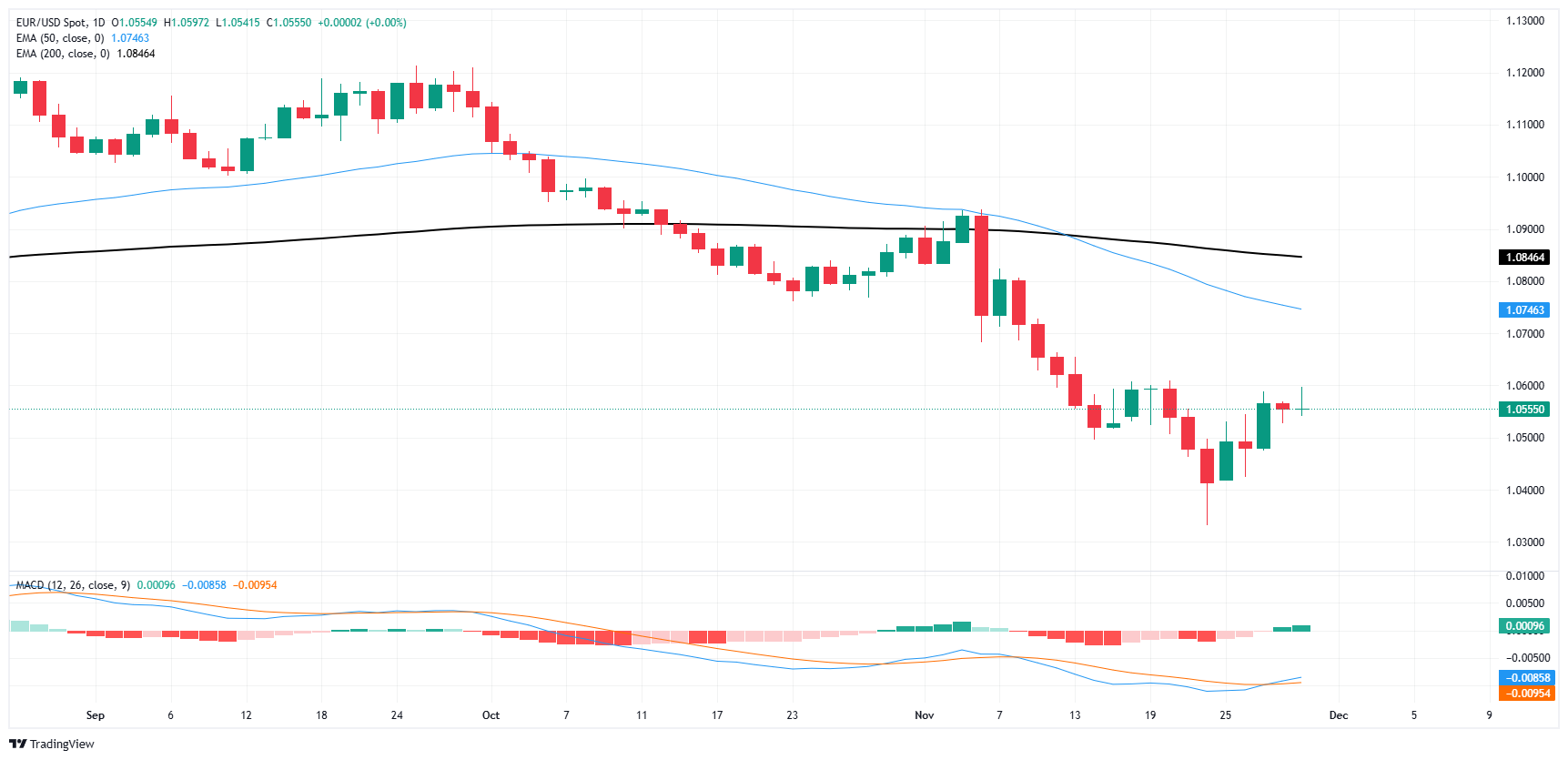EUR/USD turned lower on Friday after technical rejection from 1.06
- EUR/USD started Friday with hopeful gains, but slumped back into the low side.
- European inflation figures showed contraction on the near end of the curve.
- Core monthly HICP inflation dipped to its lowest level since February.
EUR/USD kicked Friday off with a mild rally into the 1.0600 handle as broader markets took advantage of the US holiday session to sell off the Greenback and bid up riskier assets, but another contraction in key pan-European inflation figures pulled the plug on Fiber bulls. Despite an intraday softening of the Euro’s stance, EUR/USD is poised for its first weekly gain in a month.
According to the Harmonized Index of Consumer Prices (HICP), headline European inflation sank to -0.3% in November, falling from the previous month’s 0.3%. Core HICP inflation also declined to -0.6% MoM compared to the previous print of 0.2%, sending core monthly inflation measures into contraction territory for the third time this year and the lowest print since February.
Annualized HICP inflation ticked higher, with core HICP rising to 2.8% YoY from the previous 2.7%, but the bump in yearly inflation is likely due to previous bumps in the road as the European Central Bank (ECB) grapples with whipsaw inflation prints. ECB officials noted that still-declining inflation metrics bode well for further rate cuts. Still, too-steep of an inflation easing curve is raising investor concerns of a deepening slowdown within the broader European economy.
EUR/USD price forecast
The Euro’s bullish turnaround from two-year lows is already running into trouble as intraday bidding runs aground of the 1.0600 handle. Bullish momentum has achieved a moderate 2.5% recovery from November’s bottom bids near 1.0330, but momentum remains limited. Looking higher up, a rapidly-descending 50-day Exponential Moving Average (EMA) falling through 1.0750 while the 200-day EMA rolls over into bear country near 1.0840.
EUR/USD daily chart
Euro FAQs
The Euro is the currency for the 19 European Union countries that belong to the Eurozone. It is the second most heavily traded currency in the world behind the US Dollar. In 2022, it accounted for 31% of all foreign exchange transactions, with an average daily turnover of over $2.2 trillion a day. EUR/USD is the most heavily traded currency pair in the world, accounting for an estimated 30% off all transactions, followed by EUR/JPY (4%), EUR/GBP (3%) and EUR/AUD (2%).
The European Central Bank (ECB) in Frankfurt, Germany, is the reserve bank for the Eurozone. The ECB sets interest rates and manages monetary policy. The ECB’s primary mandate is to maintain price stability, which means either controlling inflation or stimulating growth. Its primary tool is the raising or lowering of interest rates. Relatively high interest rates – or the expectation of higher rates – will usually benefit the Euro and vice versa. The ECB Governing Council makes monetary policy decisions at meetings held eight times a year. Decisions are made by heads of the Eurozone national banks and six permanent members, including the President of the ECB, Christine Lagarde.
Eurozone inflation data, measured by the Harmonized Index of Consumer Prices (HICP), is an important econometric for the Euro. If inflation rises more than expected, especially if above the ECB’s 2% target, it obliges the ECB to raise interest rates to bring it back under control. Relatively high interest rates compared to its counterparts will usually benefit the Euro, as it makes the region more attractive as a place for global investors to park their money.
Data releases gauge the health of the economy and can impact on the Euro. Indicators such as GDP, Manufacturing and Services PMIs, employment, and consumer sentiment surveys can all influence the direction of the single currency. A strong economy is good for the Euro. Not only does it attract more foreign investment but it may encourage the ECB to put up interest rates, which will directly strengthen the Euro. Otherwise, if economic data is weak, the Euro is likely to fall. Economic data for the four largest economies in the euro area (Germany, France, Italy and Spain) are especially significant, as they account for 75% of the Eurozone’s economy.
Another significant data release for the Euro is the Trade Balance. This indicator measures the difference between what a country earns from its exports and what it spends on imports over a given period. If a country produces highly sought after exports then its currency will gain in value purely from the extra demand created from foreign buyers seeking to purchase these goods. Therefore, a positive net Trade Balance strengthens a currency and vice versa for a negative balance.

